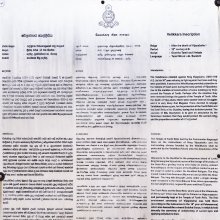Puram, Puṟam: 8 definitions
Introduction:
Puram means something in Hinduism, Sanskrit, the history of ancient India, Jainism, Prakrit, Tamil. If you want to know the exact meaning, history, etymology or English translation of this term then check out the descriptions on this page. Add your comment or reference to a book if you want to contribute to this summary article.
Puram has 7 English definitions available.
Images (photo gallery)
Languages of India and abroad
Sanskrit dictionary
[Deutsch Wörterbuch]
Source: Cologne Digital Sanskrit Dictionaries: Sanskrit-Wörterbuch in kürzerer FassungPūram (पूरम्):—Absol. von 1. par in udara , ūrdhva , goṣpada (Nachtr.
3) und sruva.
Sanskrit, also spelled संस्कृतम् (saṃskṛtam), is an ancient language of India commonly seen as the grandmother of the Indo-European language family (even English!). Closely allied with Prakrit and Pali, Sanskrit is more exhaustive in both grammar and terms and has the most extensive collection of literature in the world, greatly surpassing its sister-languages Greek and Latin.
See also (Relevant definitions)
Starts with (+48): Pura-matirceri, Pura-mattainar, Puramadhya, Puramadhyastha, Puramalai, Puramalavitti, Puramalin, Puramalini, Puramanai, Puramanam, Puramanovijnana, Puramarai, Puramarga, Puramaru, Puramashina, Puramatai, Puramatam, Puramathana, Puramathanavallabha, Puramathitar.
Ends with (+147): Aadi pooram, Aka-tinaipuram, Akkira-calaipuram, Allaippuram, Amalainimpuram, Amarapuram, Amutapuram, Anantapuram, Andalipuram, Antappuram, Anuratapuram, Arappuram, Aratikarppuram, Arjunapuram, Astinapuram, Aticirpuram, Atippuram, Attinapuram, Aval-amutupuram, Avaniyapuram.
Full-text (+417): Udarapuram, Urdhvapuram, Vitiyarpuram, Shashankapura, Kilapuram, Muppuram, Aram-puram-akapecu, Porulilakkanam, Purampati, Purattirattu, Purampo, Tanippuram, Merpuram, Patippuram, Ciru-purampecu, Shonitapura, Puramjanacarita, Puramdaracapa, Puramdarapuratithi, Puramjananataka.
Relevant text
Search found 52 books and stories containing Puram, Puṟam, Puraṃ, Pūram, Pooram; (plurals include: Purams, Puṟams, Puraṃs, Pūrams, Poorams). You can also click to the full overview containing English textual excerpts. Below are direct links for the most relevant articles:
Garga Samhita (English) (by Danavir Goswami)
Verse 1.2.31 < [Chapter 2 - Description of the Abode of Śrī Goloka]
Verse 4.6.27 < [Chapter 6 - The Story of the Ayodhyā Women]
Verse 6.4.24 < [Chapter 4 - Journey to the City of Kuṇḍina]
Rig Veda (translation and commentary) (by H. H. Wilson)
Brihad Bhagavatamrita (commentary) (by Śrī Śrīmad Bhaktivedānta Nārāyana Gosvāmī Mahārāja)
Verse 2.1.166 < [Chapter 1 - Vairāgya (renunciation)]
Verse 2.4.255 < [Chapter 4 - Vaikuṇṭha (the spiritual world)]
Verse 1.4.1 < [Chapter 4 - Bhakta (the devotee)]
Sahitya-kaumudi by Baladeva Vidyabhushana (by Gaurapada Dāsa)
Text 10.125 < [Chapter 10 - Ornaments of Meaning]
Text 10.2 < [Chapter 10 - Ornaments of Meaning]
Text 9.51 < [Chapter 9 - Ornaments of Sound]
Sanskrit sources of Kerala history (by Suma Parappattoli)
16. Yamaka poems of Vasudeva < [Chapter 6 - Miscellaneous Sanskrit works bearing on Kerala history]
Tiruvaymoli (Thiruvaimozhi): English translation (by S. Satyamurthi Ayyangar)
Pasuram 5.1.6 < [Section 1 - First Tiruvaymoli (Kai ar Cakkarattu)]
Pasuram 1.1.8 < [Section 1 - First Tiruvaymoli (Uyarvu ara Uyar Nalam)]
Related products

